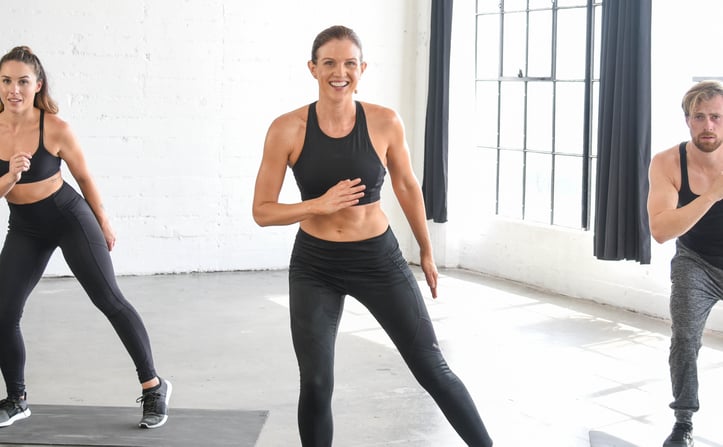Beyond the Basics: Fresh Programming Ideas for Your Traditional Cardio Workouts (Part 2)

Beyond the Basics: Fresh Programming Ideas for Your Traditional Cardio Workouts (Part 2)
Introduction: Taking Your Cardio to the Next Level!
Welcome back! In Part 1 of our journey into revitalizing traditional cardio, we explored some foundational concepts to break the monotony and boost effectiveness. Now, in this exciting second installment, we're diving even deeper, uncovering more innovative and engaging ways to supercharge your cardiovascular routine.
We all know that cardio exercise is a non-negotiable cornerstone of a healthy, energetic lifestyle. It’s fantastic for your heart, a great ally in weight management, a super booster for your endurance, and a powerful tool for enhancing your overall well-being. However, let's be real – slogging through the exact same cardio exercises day in and day out can lead to boredom, plateaus, and a dip in motivation. That’s precisely where these fresh programming ideas come in to shake things up!
Interval Training Variations: Unleash Your Inner Athlete
One of the most dynamic and effective ways to spice up (and significantly improve!) your cardio routine is through the magic of interval training. Instead of maintaining a steady, unchanging pace throughout your entire workout, interval training has you alternating between invigorating short bursts of high-intensity exercise and periods of active recovery or lower-intensity work.
-
Tabata Intervals: The 4-Minute Fitness Blast
- What it is: Tabata is a specific, highly popular form of high-intensity interval training (HIIT). It follows a precise formula: 20 seconds of all-out, intense exercise followed by 10 seconds of complete rest (or very low-intensity movement), repeated for a total of 8 rounds (equaling just 4 minutes per Tabata set).
- How to try it: Think maximum effort for those 20 seconds! You could do 20 seconds of all-out sprints on a treadmill or stationary bike, followed by 10 seconds of slow pedaling or walking. Other great Tabata exercises include jump squats, burpees, or high knees.
- Why it’s powerful: Despite its short duration, Tabata training has been scientifically shown to significantly increase both aerobic (endurance) and anaerobic (power) fitness levels. It’s a fantastic way to get a potent workout in minimal time.
-
Fartlek Training: "Speed Play" for Fun and Flexibility
- What it is: Fartlek, a Swedish term meaning "speed play," is a wonderfully flexible and unstructured form of interval training. Instead of strict timed intervals, you vary the intensity and duration of your efforts based on how you feel, your surroundings, or pre-determined landmarks.
- How to try it: This is perfect for outdoor runs or cycling! For instance, during a run in the park, you might decide to sprint to a specific tree, then jog slowly to the next bench, walk briskly up a hill, and then cruise at a moderate pace for a few minutes. Let your creativity guide you!
- Why it’s great: Fartlek training keeps things interesting, helps you learn to tune into your body's signals, and can make outdoor workouts feel more like play than a chore.
Incorporating Functional Movements: Train for Life, Not Just the Gym
Another fantastic way to make your cardio workouts more engaging and highly effective is to incorporate functional movements. These are exercises that mimic real-life activities and natural movement patterns, engaging multiple muscle groups simultaneously. This not only gets your heart rate up but also builds strength that translates directly to everyday life.
-
Kettlebell Swings: The Full-Body Powerhouse
- What it is: This dynamic, compound exercise is a cardiovascular champion that also powerfully works your glutes, hamstrings, core, back, and shoulders.
- How to do it (simplified): Stand with your feet slightly wider than shoulder-width apart, holding a kettlebell with both hands in front of you (arms long). Hinge at your hips (push your hips back, keeping a slight bend in your knees and a flat back), allowing the kettlebell to swing back between your legs. Then, powerfully drive your hips forward, squeezing your glutes, to swing the kettlebell up to about chest height. Let gravity bring it back down in a controlled manner as you hinge at the hips again.
- Why it’s a winner: It’s incredibly efficient for building explosive power, muscular endurance, and cardiovascular fitness all at once. Start with a light kettlebell and prioritize form!
-
Burpees: The Ultimate Love-to-Hate Functional Move
- What it is: The burpee is a classic full-body functional movement that combines a squat, a push-up, and an explosive jump. It’s renowned for its ability to jack up your heart rate and build serious strength and endurance.
- How to do it (simplified): Start in a standing position. Lower your body into a squat and place your hands on the ground in front of your feet. Jump or step your feet back into a plank position. Perform a push-up (optional for beginners). Jump or step your feet back towards your hands, returning to the squat position. Finally, explode up into a jump, reaching your arms overhead.
- Why it’s so effective: Burpees leave no muscle untouched and are a fantastic way to challenge your cardiovascular system and build resilience. Modify as needed – skip the push-up or the jump to start.
Using Technology to Your Advantage: Smart Tools for Smarter Training
In today's digital age, we have access to an incredible array of tools and apps that can help you understand your body better and optimize your cardio workouts.
-
Heart Rate Monitors: Your Internal Intensity Gauge
- How they help: Monitoring your heart rate during exercise is a fantastic way to ensure you're working at the right intensity level for your goals – whether that's building endurance, burning fat, or improving cardiovascular health. Knowing your heart rate zones can help you push when you need to and ease off when appropriate.
- Types available: There are various types, from accurate chest straps to convenient wrist-based monitors found on smartwatches and fitness trackers.
- The benefit: By keeping an eye on your heart rate, you can make real-time adjustments to the intensity of your workout, ensuring you're getting the maximum benefit from your efforts and training safely.
-
Fitness Tracking Apps & Wearables: Your Personal Coach & Data Hub
- How they help: These apps and devices can be incredibly motivating. They can help you track your progress over time (distance, pace, duration, calories burned), set achievable goals, discover new workout plans, and even connect with a community of like-minded individuals.
- Popular options: Many great apps exist, such as Strava (great for runners and cyclists), MyFitnessPal (for nutrition and exercise tracking), Nike Training Club (for guided workouts), and countless others. Many also seamlessly connect with your smartwatch or fitness tracker (like Fitbit, Garmin, Apple Watch) to give you a comprehensive overview of your activity and health data.
- The benefit: Seeing your progress visually can be a huge confidence booster! Plus, many apps offer challenges and insights that can keep your routine fresh and exciting.
Conclusion: Elevate Your Cardio, Elevate Your Health!
By thoughtfully incorporating these fresh programming ideas into your traditional cardio exercises, you can truly take your workouts to the next level, break through plateaus, and achieve even better results – all while keeping things interesting and enjoyable! Whether you're just starting your fitness journey or you're a seasoned exerciser looking for new challenges, there's always room for innovation and improvement in your routine.
So, don't be afraid to step outside your comfort zone, try something new, and challenge yourself in positive ways. Your body is incredibly adaptable and will thank you for the variety and the thoughtful effort!
Remember, consistency is key when it comes to achieving your fitness goals. Aim to schedule regular cardio workouts into your week and stick with them as best as you can, listening to your body along the way.
Now, it's your turn! Get out there, get moving, and start experimenting with some of these new programming ideas. We're confident you'll feel the difference. And if you have any questions, your own favorite cardio programming tips, or experiences to share, please feel free to leave them in the comments below. We'd absolutely love to hear from you!
References (Example Format)
- American Council on Exercise (ACE). (Date of publication/retrieval). Title of Article/Resource on Interval Training. Retrieved from [Link to ACE website]
- National Academy of Sports Medicine (NASM). (Date of publication/retrieval). Title of Article/Resource on Functional Training. Retrieved from [Link to NASM website]
- Harvard Health Publishing. (Date of publication/retrieval). Title of Article/Resource on Heart Rate Monitors. Retrieved from [Link to Harvard Health website]
- National Institutes of Health (NIH) / U.S. Department of Health & Human Services. (Date of publication/retrieval). Physical Activity Guidelines for Americans. Retrieved from [Link to health.gov PAGuidelines]

Fit vs Fat: Decoding Health's True Ruler

Pump Up Your Heart: Science-Driven Weight Loss

Wellness Technology: Your Path to Sustainable Weight Loss

A Sensible Guide to Dietary New Year's Resolutions

Prevent Shoulder and Rotator Cuff Injuries with Corrective Exercises

Overcome Fitness Plateaus: 4 Tips for Success

10 x 10 Thanksgiving Day Circuit: A Fitness Guide

Unleash Your Fitness Potential with Kit Rich's Training Secrets

The Future of Fitness: A Guide for Beginners to Intermediates

